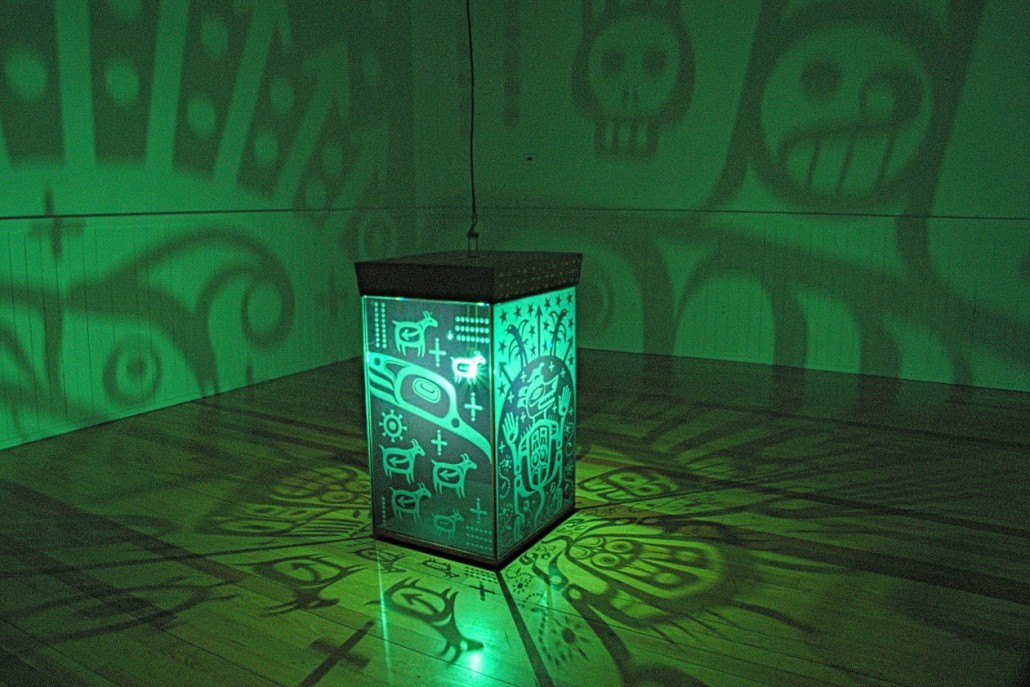Waterline
June 19 – August 1
Marianne Nicolson
Curated by Arin Fay
Artists Statement:
My ancestry is comes from the Dzawada’enuxw of the Kwakwaka’wakw Nations. Our ancestral home is at Gwa’yi along the Kingcome River on the mainland coast of British Columbia. The river is our mainstay, a constant in an existence of unknowns. Our origin story describes our coming to live within this river valley in ancient times. In 2010, the Kingcome River experienced flooding of previously unknown proportions and the entire village was evacuated by helicopter. Since then the village has been rebuilt but the memory of this flood remains a tangible part of our day to day reality. In a sense the feeling of apprehension we experience at the local level seems to be also reflected in general society due to the uncertainty of global warming and the relationship between nature and industry that has influenced its birth.
The artwork “Watermark” expresses this relationship in poetic and complex ways. A glass “bentwood” box is situated in the centre of the gallery. It has as imagery a combination of British Columbia coastal and interior Indigenous references. A boy emerges from a Thunderbird, a wolf wears an otter as a head dress, mountain goats mill around a birds head, a hunting dog barks at a large whale. Crosses, circles arrows and a skull reference painted pictographs. There is slightly spiritual questioning present in the overall composition: a questioning of the relationship of man to nature and to “god”. Whatever that means…with all the historical complexity of the colonial church and state.
A mechanical device suspended from the ceiling moves an armature with a light up and down within the inside of the box through a hole cut through the cedar lid. The movement is almost imperceptible but the sound of the motor that operates it is tangible and impossible to ignore. As the light moves from up to down, the shadows of the incised images on the box are cast upon the floor and slowly spill outwards across the floor and finally up the walls. It is a symbolic flooding. The light upon its return to its original position causes the “shadow waters” to recede and once more return to the box.
The work references the damming of river systems for hydro-electric power and flood control. After providing sustenance and a way for life for thousands of years to numerous Indigenous Nations within a 50 year period the Columbia River system was dammed 14 times on its mainline completely altering the existence of the river system and the peoples who were reliant on it for its abundant salmon runs. In 1931 Kootenay Lake, part of the Columbia River system, was dammed, providing a stucture that could control and rise and fall of the level of the lake. During this process ancient pictographs have become alternately submerged and revealed.
Overall, the work speaks to the relationship of industry and the land. It speaks of the submergence of Indigenous presence and histories and attempts to make them visible. It reflects upon, on particular, the contemporary issues of outstanding Indigenous land claims and the awkward balancing act of industrial development and environmental stewardship. As audience to the work, viewers are implicated as their shadows are cast and visually included in this complex narrative as the gallery space is “flooded” with light and imagery.
Curator’s Statement
Marianne Nicolsons’ work acknowledges important environmental concerns (specifically water issues), Aboriginal history (cultural & artistic practice; pictographs) and presents an invaluable opportunity for Kootenay area youth and the public generally to focus on ‘our’ shared cultural and environmental legacies, both from a broad (national, global) and local perspective.
The exhibition, shown in Kaslo and Castlegar comments on the state of the Columbia and the Kootenay Rivers, which join together in Castlegar. Kaslo sits on the shore of Kootenay Lake which is connected to the Kootenay river, one of the biggest tributaries of the Columbia and is heavily damned (7 in total; 4 run-of-the-river dams producing hydro-power). Both of these massive rivers ignore the border between Canada and the States, just as both of these rivers are intricately tied to the many waterways which define and dictate settlement in British Columbia, pre-contact to present day. Marianne Nicolson’s passionate commitment to Aboriginal and environmental issues is evident in much of her previous and in-progress work and we are very honoured that she is focusing her artistic lens on our place within this important environmental context.
Ms. Nicolson’s exhibition will be showing at the Langham Art Gallery in Kaslo (April 17-May 31, 2015) and at the Kootenay Gallery of Art and Science in Castlegar (June 19-Aug 1, 2015). The arts and education project will deliver outreach to the youth of the Kaslo area (Kaslo, Lardeau, Meadow Creek, Argenta, Ainsworth) and Castlegar via the galleries in question (Langham Gallery and Kootenay Gallery) and through the youth centers and groups in these communities (Kaslo Youth Centre, LardeauVallery Community Centre).

